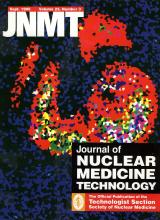Abstract
Purpose: This paper evaluates the utility of a new 90°-angled two-detector (2-DT) camera for 99mTc-sestamibi imaging.
Materials and Methods: SPECT acquisitions obtained on a single-detector camera (1-DT) were repeated with a two-detector camera (2-DT) with similar performance characteristics in 30 patients studied using different combinations of 1-DT and 2-DT protocols. Acquisition time for the 2-DT was half that for the 1-DT for 29 studies (12 stress, 17 rest) yielding similar image count density. For another 21 studies (11 stress, 10 rest) 2-DT acquisition time was equal to that for 1-DT scans, yielding double the 1-DT count density. Defect extent and severity were quantified by comparison to normal limits.
Results: By blinded qualitative analysis, 2-DT 12.5 min scans identified perfusion defects better than 1-DT 25 min scans in 6 out of 29 cases (21%, p = 0.13). Twenty 5-min 2-DT scans identified defects better than 25-min 1-DT scans in 5 out of 21 cases (24%, p = 0.017). In all cases image quality was best for 25-min 2-DT, double-count density scans. In patients scanned by all three methods, defect extent and severity correlated well (r = 0.90 to 0.96). Defect extent and severity were slightly less with the two-detector half-time acquisition than with the single-detector acquisition (p = 0.0006 and 0.005, respectively). Otherwise, no differences in defect extent or severity were demonstrated using the acquisition techniques described.
Conclusion: We conclude that the new 90°-angled 2-DT camera provides sestamibi SPECT images of diagnostic quality equivalent to those of a 1-DT camera using half the acquisition time. Image quality can be substantially improved using an acquisition time equal to 1-DT SPECT.







